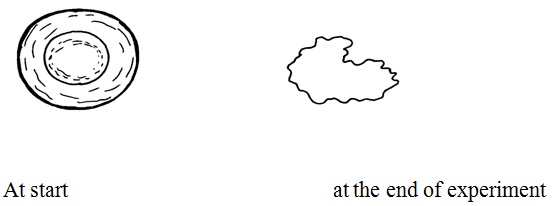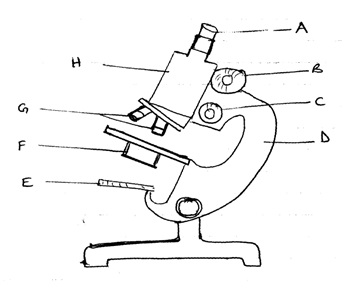Question 1
State the functions of the following parts of a light microscope:
a) Objective lens
b) Diaphragm
Answer
a) objective lens - magnification of the objective/image
b) Diaphragm – regulates /adjusts /controls amount of light
b) Diaphragm – regulates /adjusts /controls amount of light
Question 2
State the functions of the following cell organelles:
a) Ribosomes
b) Lysosomes
Answer
a) Ribosomes – protein synthesis
b) Lysosomes – Breakdown worn out cells/organelles/food materials
b) Lysosomes – Breakdown worn out cells/organelles/food materials
Question 3
Distinguish between diffusion and active transport
Answer
a) In diffusion molecules move/along concentration gradient from a highly concentrated region
to a lowly concentrated region while in active transport molecules move/against concentration gradient from a lowly concentrated region to a highly concentrated region.
b) No energy is required in diffusion while energy is required in active transport
c) In diffusion no carrier molecules are required while in active transport carrier molecules are required
b) No energy is required in diffusion while energy is required in active transport
c) In diffusion no carrier molecules are required while in active transport carrier molecules are required
Question 4
The diagram below a red blood cell that was subjected to a certain treatment.

a) Account for shape of the cell at the end of the experiment.
b) Draw a diagram to illustrate how a plant cell would appeared if subjected to the same treatment.
Answer
a) The red cell was placed in a hypertonic solution. It lost water by osmosis and remained crenated
b)

b)

Question 5
Plant cells do not burst when immersed in distilled water. Explain
Answer
Presence of cell wall which is rigid/does not stretch/tough
Question 6
State three functions of Golgi apparatus.
Answer
- Secretion of substances;/hormones/enzymes/ polysaccharides /glycoproteins/synthesized proteins/carbohydrates
- Packaging of carbohydrates and proteins/glycoproteins/synthesized materials
- Modification of carbohydrates and proteins/formation of glycoproteins
- Transport of carbohydrates/proteins/ glycoprotein/lipids
- Production of lysosomes
- Packaging of carbohydrates and proteins/glycoproteins/synthesized materials
- Modification of carbohydrates and proteins/formation of glycoproteins
- Transport of carbohydrates/proteins/ glycoprotein/lipids
- Production of lysosomes
Question 7
Name one cell organelle found in the actively respiring tissues.
Answer
Mitochondrion
Question 8
The diagram below a red blood cell that was subjected to a certain treatment.

a) Name the parts labelled A, B, C, D,E
b) State the functions of parts labelled E and F
Answer
a)
A- Eye piece
B- Coarse adjustment knob
C- Fine adjustment knob
D- arm
E – Mirror
b)
E - regulates the amount of light passing through condenser to illuminate the specimen
F - objective lens - brings image into focus and magnifies it
A- Eye piece
B- Coarse adjustment knob
C- Fine adjustment knob
D- arm
E – Mirror
b)
E - regulates the amount of light passing through condenser to illuminate the specimen
F - objective lens - brings image into focus and magnifies it
Question 9
Name the organelle that:
a) Manufacture and transport lipids and steroids in a cell
b) Contain enzymes that are capable of destroying old damaged cells.
c) Control all the processes in a cell.
d) Form Cilia and flagella in cells that have them
Answer
a) Smooth endoplasmic reticulum
b) Lysosomes
c) Nucleus
d) Centrioles
b) Lysosomes
c) Nucleus
d) Centrioles
Question 10
State the branch of biology that deals with the study of :
(i) Insects
(ii) The relationship between organisms and their environment.
Answer
i) Entomology
ii) Ecology
ii) Ecology
Question 11
Name the field of science that specializes in the study of cells.
Answer
Cytology
Question 12
State the use of the following apparatus.
i) Pooter
ii) Sweep net
Answer
i) Pooter - for sucking small animals from rock surfaces or banks of trees
ii) Sweep net - For catching flying insects;
ii) Sweep net - For catching flying insects;
Question 13
The scientific name for beans is Phosedus Vulgaris.
a) What taxan does the term phoseodus represent.
b) State two rules that are followed when giving a scientific name to an organism
Answer
a) Genus
b)
- The genus name should begin with Capital letter and species name with a small letter
- Should be printed in italics or when handwritten should be underlined as separate words
- Should be Latinized i.e made to sound like latin words
b)
- The genus name should begin with Capital letter and species name with a small letter
- Should be printed in italics or when handwritten should be underlined as separate words
- Should be Latinized i.e made to sound like latin words
Question 14
Compare the structure of plant and animal cells.
Answer
| Plant cells | Animal cells |
|---|---|
| Have cell wall made of cellulose | Have no cell wall |
| have vacuoles filled with cell-sap | Rarely have vacuoles, if they do, then they are temporary and small |
| generally have a definite shape | Have no definite shape |
| green plants have cells with chloroplasts | Chloroplasts do not occur in animals cells |
Question 15
List seven life processes/characteristics that must take place in all living organisms.
Answer
- Reproduction
- Growth, repair and replacement
- Nutrition
- Respond to stimuli
- They move
- They respire
- They excrete
- Growth, repair and replacement
- Nutrition
- Respond to stimuli
- They move
- They respire
- They excrete
Question 16
Classify the following organisms into their kingdoms.
a) Maize,Beans
b) Mushrooms,Yeast
c) Protoza, algae
d) Bacteria
Answer
| Organisms | Kingdom |
|---|---|
| Maize,Beans | Kingdom plantae |
| Mushrooms,Yeast | Kingdom Fungi |
| Protoza, algae | Kingdom Protoctista |
| Bacteria | Kingdom Monera |
Question 17
A student was preparing a section of a plant cell to be viewed on a light microscope. Give a reason for each of the following steps:-
(i) Cutting a very thin section
(ii) Staining the section
(iii) Putting the section in water
Answer
i) For light to pass through easily
ii) To make the features more clear and distinguishable
iii) For cells to remain turgid
ii) To make the features more clear and distinguishable
iii) For cells to remain turgid
Question 18
Explain the following terms.
a) Taxonomy
b) Species
Answer
a) The science of classification
b) A group of organisms that can freely / naturally interbreed to give a fertile (viable ) off spring
b) A group of organisms that can freely / naturally interbreed to give a fertile (viable ) off spring
Question 19
State two main functions of a microscope
Answer
- Magnify/enlarge image of objects/specimen
- To improve the resolving power/ show fine details of structures that are very close to appear separate
- To improve the resolving power/ show fine details of structures that are very close to appear separate
Question 20
What is a cell?
Answer
A cell is the basic structural; and functional unit of a living organism / thing
Question 21
Define the meaning of the following terms
(i) Entomology
(ii) Genetics
Answer
(i) Entomology: study of insects
(ii) Genetics: study of inheritance; and variation.
(ii) Genetics: study of inheritance; and variation.
